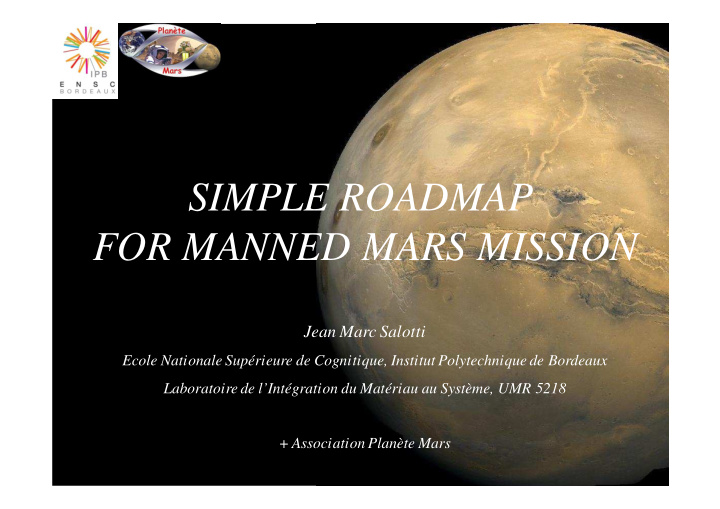



SIMPLE ROADMAP FOR MANNED MARS MISSION Jean Marc Salotti Ecole Nationale Supérieure de Cognitique, Institut Polytechnique de Bordeaux Laboratoire de l’Intégration du Matériau au Système, UMR 5218 + Association Planète Mars
Outline Introduction 1. Realistic scenarios 2. Mission requirements 3. Adaptation of Mars sample return 4. HEO mission Conclusion
1. Possible scenarios Recent studies suggest important simplifications for the first human mission to Mars [1], [2]. - Smaller crews (3 or 2x2) - < 33 tons for the landers, cargo or habitat => simplified EDL - < 46 tons for the interplanetary vehicles => no LEO assembly - All chemical - All aerocapture - In situ propellant production 4 to 6 vehicles is probably manageable [1] J.M. Salotti, Revised Scenario for Human Missions to Mars, Acta Astronautica, vol. 81, p. 273-287, 2012. [2] J.M. Salotti, Small vehicles for a robust mission to Mars, International Conference on Space Exploration, Paris, France, 17-19 December 2012.
2. Mission requirements Man rated space systems ⇒ Strict qualification procedures ⇒ Must be flight proven – Same configuration – Same environment – Same lifetime
“Flight proven” implications a) Propulsion systems must be tested with same configuration b) Habitable modules must be tested with same LSS and no support from Earth c) Aerocapture and EDL must be tested with same constraints, shape and size of vehicles d) ISPP unit, deployment and use, must be tested in the same environment
“Flight proven” implications e) Ascent from Mars must be tested f) Rendezvous in Mars orbit must be tested g) Final atmospheric Earth re-entry must be tested h) Physiology and human activities in Martian gravity must be tested => Entirely automated mission with no scientific return???
3. Adaptation of Mars sample return What about MSR for the qualification of several systems that will be used for the manned mission? Idea: approximately same vehicle (shape, size and mass) as for the manned mission Typically 31 tons at Mars entry (Salotti 2012, cargo or hab)
Mission characteristics Payload on Mars: 15 tons - Power plant: 2 tons - ISPP atmosperic unit: 1 ton - ISPP ground unit: 2 tons (NASA DRA p.107) - Robots for samples: 2 tons - Structure, packaging, deployment: 2 tons - ERV, for direct return (partially wet) : 4 tons - Margins: 2 tons Aerocapture and EDL systems: 15 tons Total for TMI: 30 tons Possible launcher: NASA SLS (> 40 tons capability)
Qualification of systems • Propulsion systems for TMI (requ. a) • Aerocapture and EDL, systems and procedures (requ. c) • ISPP unit (requ. d) • Ascent from Mars with heavy vehicle (requ. e) • Rendezvous in Mars orbit can also be tested in a symbolic way using a small orbiter (requ. f) => Must be included in the roadmap !!!
4. High Earth orbit mission ISS not appropriate: - Support from Earth - LSS not optimized for Mars mission - Different volumes, different habitat - Not adapted for Martian gravity testing LEO not adapted for testing - Earth re-entry at high velocities - Radiation shielding
HEO mission, what for? - Test/qual. the propulsion systems (requ. a) - Test/qual. the habitable modules of the Mars mission (requ. b) - Test/qual./Optimization of Earth re-entry systems and procedures (requ. g) - Tests/qual. human activities in an analog environment of Martian gravity (requ. h) - Tests of 0-g counter measures
Conclusion Simple roadmap for the preparation of the first human mission to Mars: 0: Detailed specifications of the mission 1: MSR for the qualification of critical systems 2: HEO mission for the qualification of complementary critical systems 3: First human mission to Mars
Recommend
More recommend